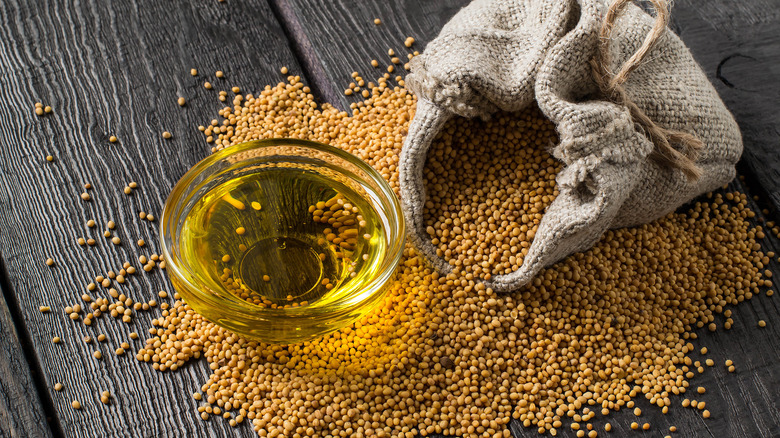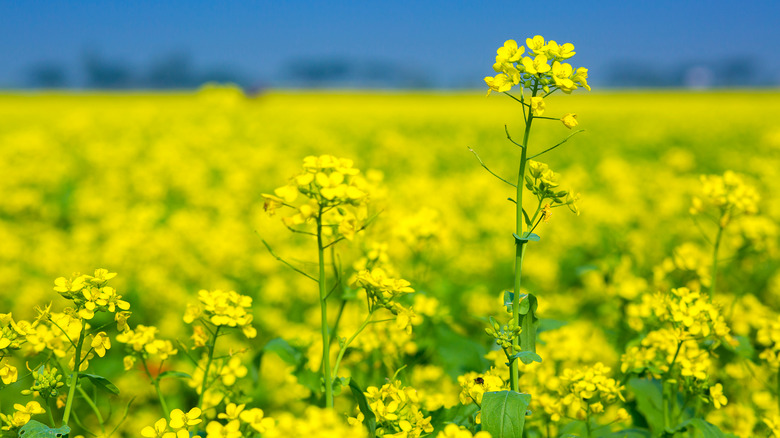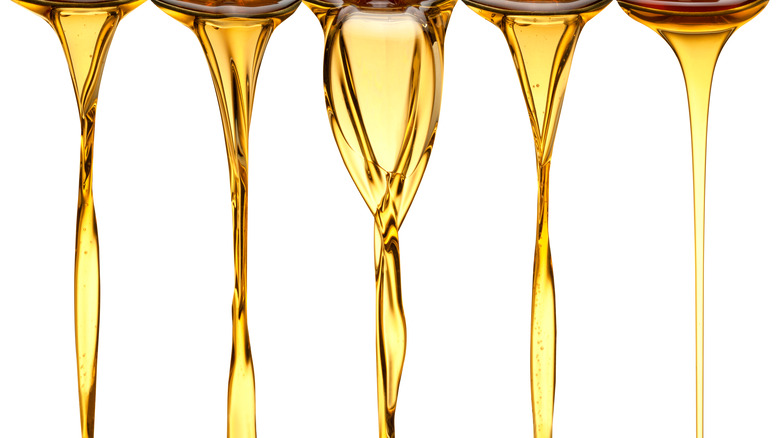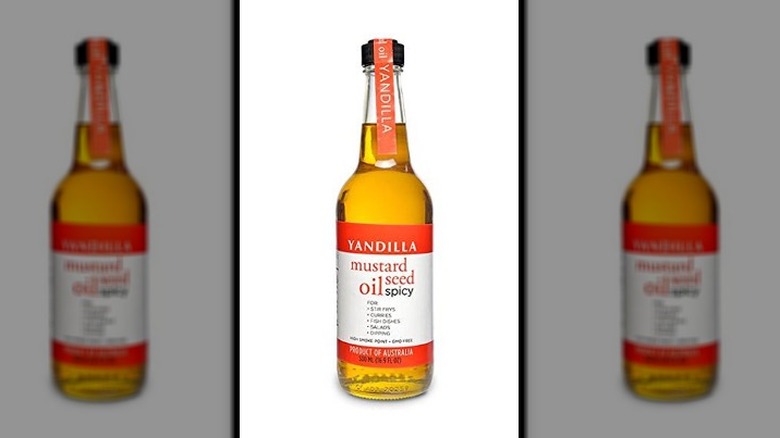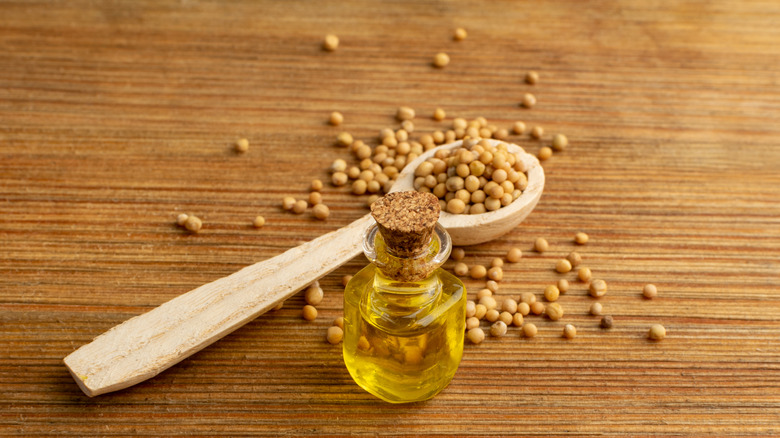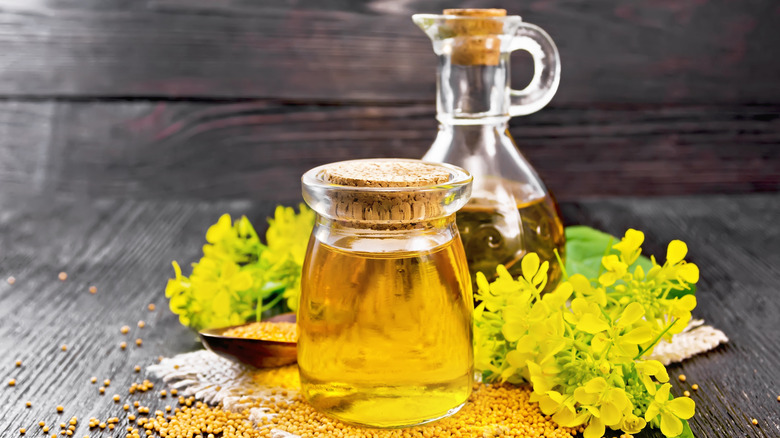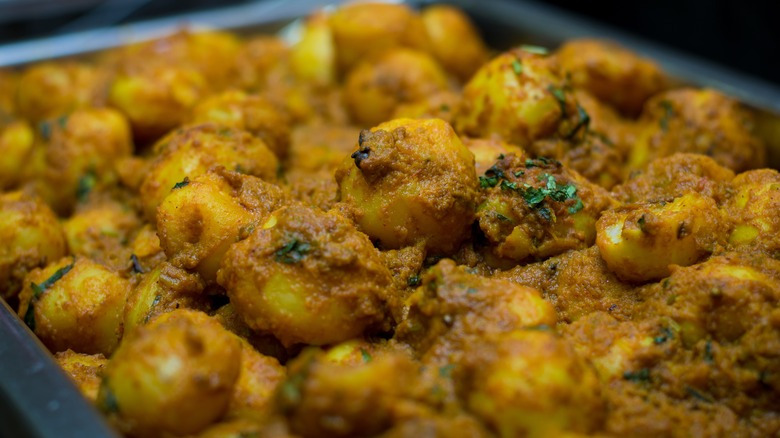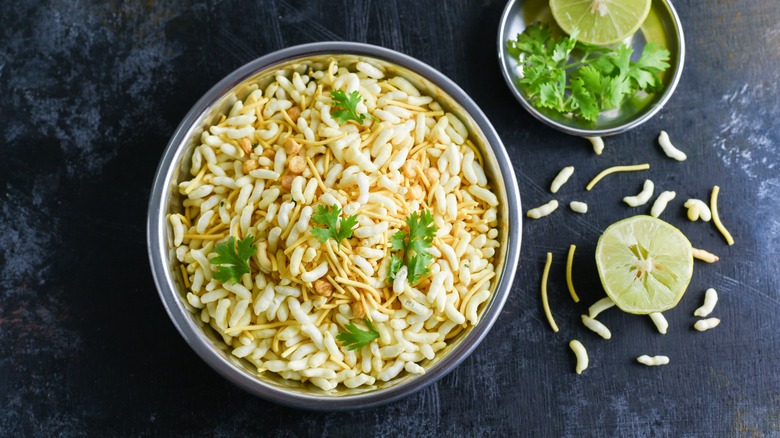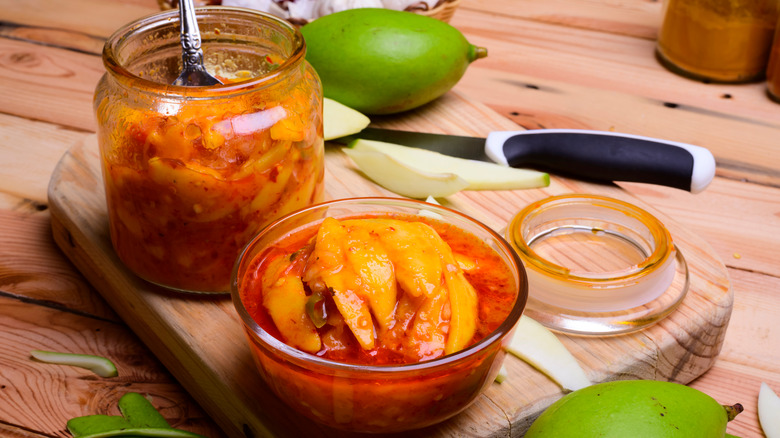Everything You Need To Know About Mustard Oil
We may receive a commission on purchases made from links.
Irreplaceable pantry essential and veritable cure-all, or poison unfit for human consumption? The fiery debate over hot and spicy mustard oil rages on with Western cultures insistently remaining in the latter camp, while many Asian cultures, especially those in Bangladesh and the Bengal region of India, steadfastly occupy the first. The answer naturally lies somewhere in between. But, before we get to that, a brief education on the oil that divides the world.
Mustard oil can be derived from either the Brassica nigra, Brassica juncea, or Brassica hirta plants; which produce black, brown, and white mustard seeds respectively, according to Bionity. The scientific research site explains that there are two types of oil that can come from the seed; a fatty vegetable oil from pressing or a volatile essential oil from grinding and distilling. Though the plants come from the same botanical family as rapeseed and are often confused with each other, mustard oil differs substantially from both rapeseed and canola oil (via Clove Garden).
For the epicureans who like to keep a garden going for culinary inspiration and inexpensive provisions, Gardening Know How suggests that growing mustard plants is not at all difficult to do. Once your plants are thriving, the gardening experts say to watch for the seed pods to turn brown as your signal that it's time to harvest. Of course, the process of turning those harvested seeds into digestible and delicious cooking oil is a bit more involved.
Where mustard oil comes from and how it's processed
According to ABC Machinery, the crude product that comes from a trip through the oil press machine is filtered until it reaches an adequate level of purity. There are five steps in the art of mustard oil production, and it all starts with sun-drying and cleaning the seeds. ABC Machinery notes that the drying process expels excess water that would impede the extraction process, and the cleaning is a quality control measure to remove dirt and debris that would otherwise foul the oil. Before the seeds are run through the press, they're heated to increase the amount of oil they'll produce, which can be as much as a 26% yield after an hour in the machine (via ABC Machinery).
After drying, cleaning, heating, and pressing, the final step is purification. Per ABC Machinery, purification requires filtering at a minimum but can include an involved process of refinement for those looking for the highest quality product. Oil refinery removes impurities from the crude oil and assures a longer shelf life by making it harder to oxidize.
Henan Kingman Mechanical & Electrical Complete Plant Co. notes that the oils of differently colored mustard seeds produce slightly different products. They say from white seeds the end result is a yellow-hued oil, and from black seeds, you'll see a lighter color coupled with a stronger taste.
Why mustard oil is labeled for external use only
The final product from the press is a seed oil that contains a controversial biological makeup including high levels of erucic acid, notes the Boston University Gastronomy Blog. According to a study published in the NFS Journal, erucic acid is a long-chain fatty acid capable of harming the cardiovascular system. As such, the study categorizes it as a naturally-occurring toxin. This is the real reason mustard oil is banned for cooking purposes in the U.S. and, therefore, labeled for external use only.
The European Food Safety Authority clarifies that, for adults, average consumption levels are nothing to be concerned about. However, they claim children under the age of 10 should not consume erucic acid, and, interestingly, the same goes for chickens. The case gets a little confusing, with the U.S. Food & Drug Administration (FDA), adding that the essential oil of mustard, also called volatile mustard oil, is a similar product that is recognized as safe and suitable for use in food as a flavoring agent.
Amidst the confusion in the west, many Asian immigrants continue to consume mustard oil, opting to simply cook with products marketed as massage oils for external use only (via Taste). However, all is not lost for American chefs determined to add the mighty mustard seed to their assemblage of always-on-hand cooking oils in the pantry. It seems there is at least one edible mustard oil that passes muster with the FDA.
FDA-approved edible mustard oil
As noted in the Import Alert 26-04 announcement published in 2016, the FDA has proclaimed that, "Expressed mustard oil is not permitted for use as a vegetable oil. It may contain 20 to 40% erucic acid, which has been shown to cause nutritional deficiencies and cardiac lesions in test animals." Further down in the alert, however, the Health and Human Services department lists one product that does meet the necessary criteria to be excluded from this ban.
Available for purchase on Amazon, the Australian brand Yandilla, in fact, features an FDA-approved food-grade mustard seed oil. The product description compares the spice level of this flavoring to wasabi and claims the oil has a high smoke point, which Healthline confirms to be about 480 F. Healthline adds that mustard oil's primary composition of monounsaturated fats adds significantly to its heat resistance.
Thanks to exclusively held non-GMO, CSIRO-bred varieties of the Brassica juncea plant, Yandilla has been able to develop a non-erucic acid seed, according to the company's website, the result of which is a low erucic acid mustard oil deemed acceptable by the FDA. If you were to get your hands on some of the spicy concoction, we recommend using it alongside the mustard seeds in this silky cream of broccoli soup recipe.
Health benefits of mustard oil
Regarding the long list of purported health benefits available from mustard oil, a 2016 study published in the journal Molecules shines the light on sinigrin; a glucosinolate found in all members of the Brassicaceae botanical family, sinigrin exists in particularly large quantities in the juncea variety of the plant used to make Indian mustard. The study states that sinigrin has been shown to contain anticancer properties as well as antibacterial, antioxidant, and antifungal elements.
In contrast to the FDA's concerns about the erucic acid in mustard oil potentially harming the cardiovascular system, Medical News Today points out that the monounsaturated fats in the oil are believed to help prevent the onset of cardiovascular disease. A systematic review by the Annals of Nutrition and Metabolism showed that diets with high concentrations of these healthy fats can lead to lowered levels of body fat and blood pressure, both of which are vital in the fight against cardiovascular disease as well as metabolic syndrome (via Lipids).
Mustard oil in Ayurvedic medicine
As defined by Johns Hopkins Medicine (JHM), Ayurveda is an ancient system of medicine that works to restore the balance of the mind, body, spirit, and environment through purification treatments, herbal remedies, specialized diets, yoga, massage, and meditation. The name is a combination of two Sanskrit words, ayur and veda, which mean life and knowledge respectively; therefore, Ayurveda directly translates to knowledge of life (via JHM).
According to the Molecules study, the use of mustard oil within the ancient traditions of Ayurveda stretches back for thousands of years; it has long been touted as a highly valued herb able to relieve a slew of issues from coughs and fevers to swelling and painful joints.
Per Ayush Herbs, the oil is called Sarso ka tel in Hindi, and when used in Ayurvedic medicine, it is massaged into the skin to lighten dark spots and act as a barrier against ultraviolet rays and other environmental pollutants. The herbal product makers further explain that mustard oil is also believed to fight against signs of aging and to improve the immune and circulatory systems.
The flavor profile of mustard oil
While it's true that the high smoke point of mustard oil is what elevates it to the level of butter as a cooking fat and makes it ideal for grilling, roasting, and frying (via Healthline), its unusually pungent flavor is what drives chefs to experiment with and rely upon it for their dishes.
In an article for the Economic Times of India, food writer and On My Plate columnist Vikram Doctor shares that the layered flavor profile of unadulterated raw mustard oil combines an intense pungency with a nostril-flaring kick of spicy heat. He claims it to be the exact opposite of standard bland and flavorless cooking oil.
Bionity points to the presence of a compound called allyl isothiocyanate for the pungency of black and brown Indian mustards. This compound, which is the result of a chemical reaction that occurs when ground seeds are chewed or mixed with a liquid, is actually the plant's primary line of defense against foraging herbivores, says the site.
Vikram Doctor notes the lingering aftertaste left by the oil, reminding us that the mustard plant belongs to the same botanical family as vegetables like cabbage and Brussels sprouts, also known for their strong flavors. For those who have yet to experience the gut-busting kick of mustard oil, consider the connection of mustard plants to those that give us wasabi and horseradish, two other well-known, often eye-watering, spices that also claim a spot on the Brassicaceae family tree.
Mustard oil in Indian cuisine
Hearing chefs from India speak about mustard oil makes it difficult to understand the controversy in the U.S., as they're far more focused on the pungent flavor and purported health benefits than they are any potential risks.
In 2017, the India Times quoted Arun Sundararaj, Executive Chef for the Taj Mahal Hotel in New Delhi, as saying, "While mustard oil complements both vegetarian and non-vegetarian ingredients, dishes such as pickles of all kinds taste best when made in mustard oil. In addition, mustard oil can be used as a salad dressing along with lemon and honey." There are many different types of pickles and dressings to choose from, and it might be fun to switch up the oils you'd normally use the next time you're experimenting in the kitchen.
Per India Times, Sundararaj further fleshed out the Indian obsession with mustard oil. "There are some ingredients that can never be replaced in the Indian kitchen and mustard oil is one such essential because of its unique and pungent flavor." He went on to suggest some mustard-oil-influenced Indian recipes you should try, including Bengali fish dishes such as sarson bata maach and paturi fish. The chef added that mutton and chicken are also quite good when cooked in the uniquely flavored and textured oil.
It may be worth keeping in mind that in order to create such layered and flavorful dishes, Indian cooking methods tend to rely on lots of spice and plenty of heat.
Mustard oil in Bangladeshi cuisine
Over the Padma River in Bangladesh, mustard oil continues to enjoy revered status with self-proclaimed global bazaar Snuk referring to it as a pantry essential. In the article by Snuk, MasterChef UK finalist Saira Hamilton calls mustard oil "the predominant flavor" of Bangladeshi cuisine, recommending cooks add it to a curry as the last ingredient in order to "brighten all the flavors." If you haven't been able to secure yourself a bottle of the oil for cooking purposes, Snuk Foods offers a tip for a homemade batch: Simply crush mustard seeds and infuse them into any standard cooking oil.
According to Whetstone Magazine, bhorta may be the most popular and beloved dish to ever come out of Bangladesh, and the sharp bite of mustard oil is a key component. Even celebrity chef Nigella Lawson uses it in her recipe for the South Asian staple. When trying your own hand at creating a bhorta, Whetstone Magazine notes that there are many variations on the classic recipe.
Another iconic Bangladeshi dish that relies on a pungent kick is jhal muri, spicy puffed rice (pictured above) predominantly found among street food vendors. BBC Travel also interviewed Hamilton, who showcases her jhal muri recipe within the first pages of her acclaimed and bestselling cookbook "My Bangladesh Kitchen." Per BBC Travel, jhal muri along with its signature splash of raw, sweat-inducing mustard oil is to be found everywhere across the country with recipes stretching to nearby Nepal.
Pickling with mustard oil
Traditionally fermented pickles have probiotic properties and are healthy for the gut, notes The Hindu. They contain strains of bacteria known to increase both the population and diversity of beneficial bacteria in the gut (via Ixcela). The Hindu adds that, for some, the high salt content of pickles may be off-putting, however, they do not need to be consumed in large quantities in order to be good for us.
Per The Economic Times of India, pickles are prevalent all across the country, with each area offering techniques and flavorings as different as sweet chhunda mango and hot avakkaya. You'll find all sorts of foods put through the pickling ringer, and yet, the one common ingredient across all of these recipes will be mustard oil, says Puri Oil Mills Limited. In fact, under a heading for correct ingredients, the Times of India suggests that olive oil will not suffice when making Indian pickles, and that mustard oil is to be used instead.
If all this talk of pickling has got you in the mood to break out the jars and get canning, look no further than to some of our favorite pickle recipes. We'll set you up with inspiration, as well as step-by-step instructions for making your pickles in line with Korean, French, Middle Eastern, and Indian traditions to boot. For anyone with safety concerns regarding pickling, such as botulism and mold, the National Center for Home Food Preservation is a good resource.
The economic profile and future of mustard oil
A 2017 article by Science Nordic claims that scientists have created a toxin-free variety of the mustard plant, making its oil a potential edible replacement for rapeseed oil. That's no small feat given that rapeseed is the third largest crop in the world used to make oil, per the article. It's exciting news, especially considering the scientific evidence that backs up the claim, showing there's a way to genetically mutate mustard plants so they contain a drastically reduced amount of glucosinolates. A mustard oil with low levels of the toxins banned by the FDA could open the floodgates to a burgeoning international market for the beloved cooking essential, creating a boon to family farmers.
Wholesale prices for mustard oil have come down 10% throughout 2022, which should be appreciated by consumers on the retail end, reports The Economic Times of India. Concurrently, says the outlet, mustard crop acreage has increased by nearly 2 million hectares. It'll be interesting to see what happens globally. At the same time, Asia is experiencing an increase in successful crops, North America is reeling from a sharp decrease, which could actually signal that a mustard shortage is on the way.
Catastrophic rains in British Columbia towards the end of 2021 (via NPR) coupled with excessive heat across southern Canada, says AGCanda dealt the country's mustard seed supply chain a tremendous blow. It seems that, for now anyway, the economic future of mustard oil is up in the air.
Other uses for mustard oil
It's common across India for people to use mustard oil as a beauty product, reports India Today. They say the oil can be used to whiten teeth when mixed with salt and lemon juice, to cleanse the skin when used as a makeup remover, be mixed into a face mask concoction, and prevent frizz when heated and massaged into the hair. This last use is quite popular, and there are good reasons for it. Per Healthline, mustard oil can go a long way to increase moisture in your hair while improving its health and shine.
The high contents of natural fats contained in the oil (via NutritionValue.org) have the potential to help with issues like breakage, a dry scalp, split ends, and damage from heat or water, suggests Healthline. The site recommends combining mustard oil with equal parts of carrier oil such as almond and/or jojoba oil, microwaving the mixture for 10 seconds, and applying the mask to your hair. You could use a few drops on your fingertips for a scalp massage; similarly, you could rub it into your palms and then smooth it onto either just the ends of your hair or the entire length. After 30 minutes, rinse the oil out and wash your hair like you normally would.
India Today and Healthline both agree that most people will benefit from an application of mustard oil to the skin; mild reactions are possible. So, to begin with, a patch test is recommended.
